Three generations of a Marple family in whose lives The Albert Schools played an integral part (by Beth Bainbridge)
Built as a Sunday Schools for the Congregational Church on Hibbert Lane in 1866, just a year or so after the Church itself was built in 1865, The Albert Schools played a large part in the lives of my grandfather, my parents and my aunt, and myself, siblings and cousins.
About 1916, my maternal grandfather, Andrew Cochran, moved with his wife and two small daughters from Paisley in Scotland, to Marple. He was an ‘engineer’s draftsman’, and worked for Campbell & Calderwood in Paisley. They designed and made boilers for steam engines, pumps and other machinery. He moved to employment at Daniel Adamson’s at Ashton under Lyne, also makers of boilers for engines for boats, trains, foundries etc. Presumably this was important work for the war effort, and he was not in WW1, as his employment was classed as a ‘reserved occupation’.
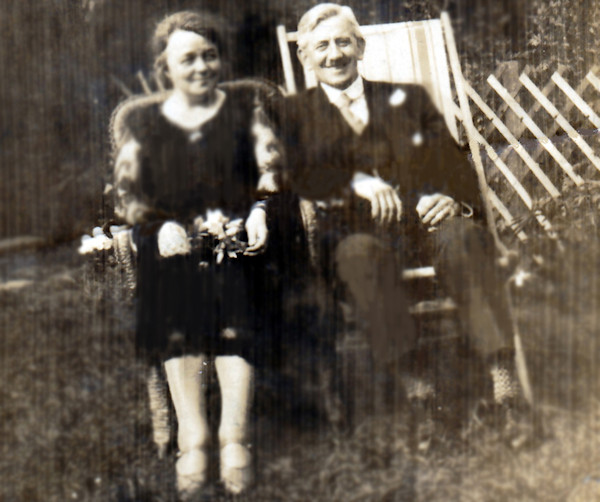 Andrew and Mary Cochran in c1926
Andrew and Mary Cochran in c1926
I know the fact that Marple, being a pleasant little village on a train line to Manchester, was a big factor in the decision as to where the family were to make their home.
In Scotland, the Cochran family had for many generations been staunch Presbyterians, and on coming to Marple, Andrew and his wife joined the Congregational Church on Hibbert Lane.
In 1868, just a couple of years after it was built, it was decided to commence a ‘Day’ School in The Albert Schools. This was two years before the 1870 Education Act which revolutionised the elementary educational system of the country.
Both Andrew Cochran’s daughters, Margaret (Peggy), and Helen Cochran, attended The Albert Day Schools up until the age of 14, the then school leaving age. They would also have attended there on a Sunday for Sunday School, and on a myriad of occasions with their parents. The family lived on Station Road, just a few doors up from The Jolly Sailor public house, so no doubt the girls walked to The Albert Schools each week day, and the whole family to the church on Hibbert Lane on Sundays.
This photo of my mother and her sister, was taken in The Albert Schools school yard about 1918. Presumably in the ‘Girls yard’, as I believe there were separate yards, and school entrances, for girls and boys.
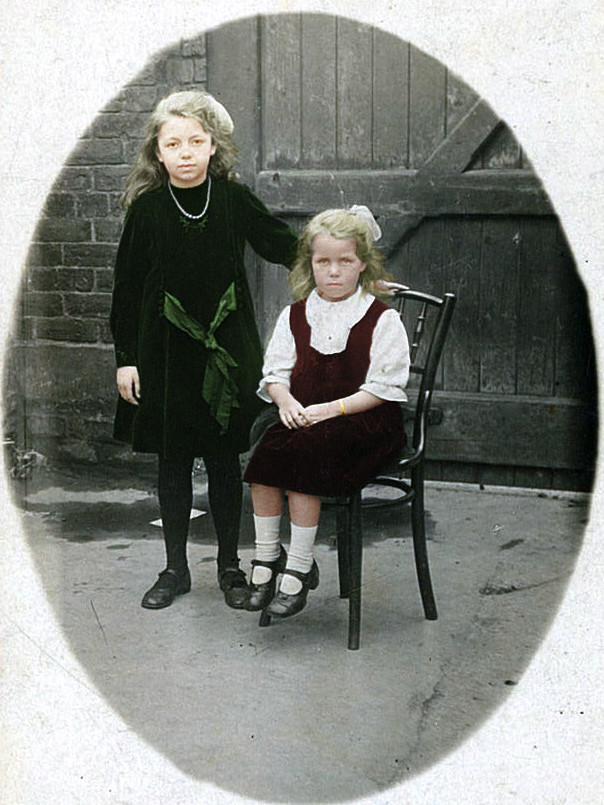
Also around 1916, my paternal grandmother and her second husband moved to Marple, strangely enough from Ashton under Lyne. They came to run The Liberal Club on Stockport road. The family lived on Stockport Road, just a few doors down from the Market Street and Hollins Lane junction, so it would not have been far to walk to The Albert Schools on Church Lane. Her son, Hugh Lane, also attended The Albert Day Schools for about 6 years leaving in 1922, again at the age of 14.
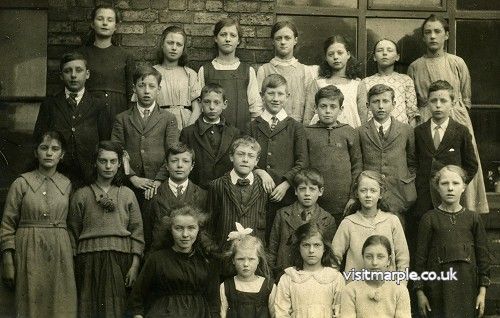 Children at The Albert Schools about 1918.
Children at The Albert Schools about 1918.
Hugh Lane is on the next to the back row, 2nd from the right.
Both my mother and father would seem to have received a good education at The Albert Day Schools, having gained a solid foundation for further education and their careers.
Margaret Cochran would have left in 1923. She went on to continue her education at Stockport Girls High School, with an eye on university, all being well. She was an outstanding mathematician, and had a desire to be a doctor. Unfortunately, her father was a casualty of the General Strike of 1926 just 3 years later, and Margaret had to leave her studies to go out to work to contribute to the family budget. She found employment readily enough in the accounts department of the LNWR, (London & North Western Railway), at Gorton Tank, just a train ride from Marple towards Manchester. Later she worked for the American company Burroughs in Manchester, as a comptometer operator (the fore-runners of calculators and computers), becoming one of the teachers at the training school there, As an American company, this was lucrative employment.
After leaving The Albert Schools in 1922, Hugh Lane then went to work as an Insurance clerk in Manchester, but continued to further his education taking courses such as typing, accounting, and shorthand, not only at Loreburn College in Manchester, but also at classes run by Marple Technical College. In a booklet from 1909/10, some of these courses, including Shorthand, were held at The Albert Schools, and it would seem he carried on part of his education there, probably as night classes. He later made his career in the Tax Offices in Stockport.
My maternal grandparents, Andrew Cochran and his wife Mary, continued to play a large part in the Hibbert Lane Congregational Church. Apart from attending the church, being on committees, and attending events at The Albert Schools, Andrew was also the church secretary for many years during the 1920s and 1930s.
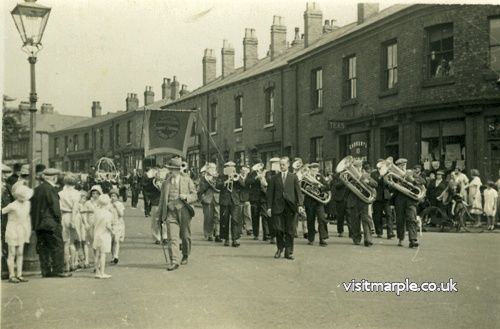 The Congregational Church walks about 1932. Andrew Cochran is the man at the front in the light coloured 3 piece suit with walking stick and trilby hat.
The Congregational Church walks about 1932. Andrew Cochran is the man at the front in the light coloured 3 piece suit with walking stick and trilby hat.
When Andrew’s wife Mary died in October 1939, her obituary in the newspaper states she was one of Marple Congregational Church’s ‘most devoted workers’, and ‘She played an active part in all efforts for church welfare’. Her obituary includes floral tributes from not only from her family, and many individual members of the Church congregation, but also from ‘The deacons and officers of the Congregational Church’ and ‘The Congregational Church Ladies Working Party’, The tributes also include ‘The staff of Daniel Adamson’s’, Marple Dramatic Society, ‘Burroughs friends’, and ‘The Marple League of Young Liberals’.
No doubt both she, and my grandfather would have spent a great deal of time at The Albert Schools being part of the many activities that went on there as part of the life of the Congregational Church community.
When The Union Rooms on Stockport Road in Marple closed in 1931, The Albert Schools received some items, including forms, a table, a Bible, and ‘36 hymnarys and Tune Books’.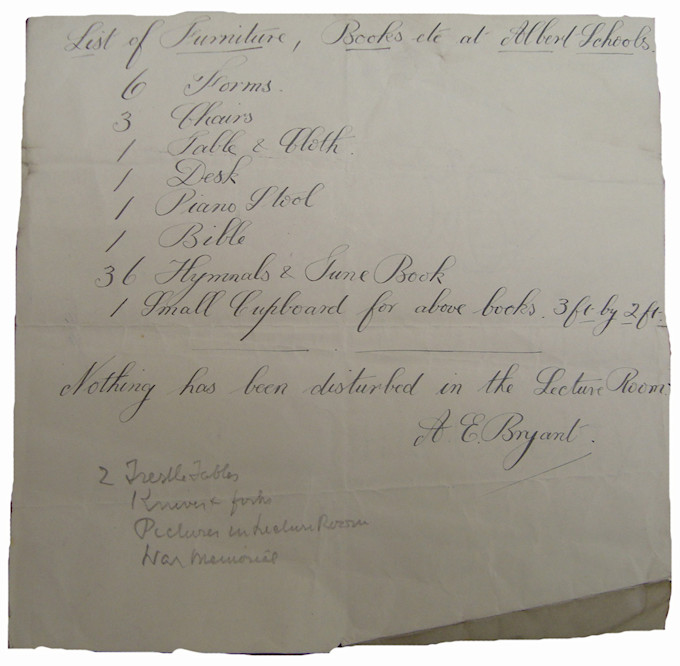 Added to the bottom of this list at a later date are: 2 Trestles; Knives & forks; Pictures in Lecture Room and a War Memorial (this must be one of the plaques rescued from the Albert Schools before demolition in 2019 by the Marple Website).
Added to the bottom of this list at a later date are: 2 Trestles; Knives & forks; Pictures in Lecture Room and a War Memorial (this must be one of the plaques rescued from the Albert Schools before demolition in 2019 by the Marple Website).
There is correspondence between my grandfather Andrew Cochran as secretary, and the Reverend C W Cliffe, Secretary of the Cheshire Congregational Union, regarding the intended closure of the Union Rooms in 1931, held in the archives at Cheshire Record Office in Chester.
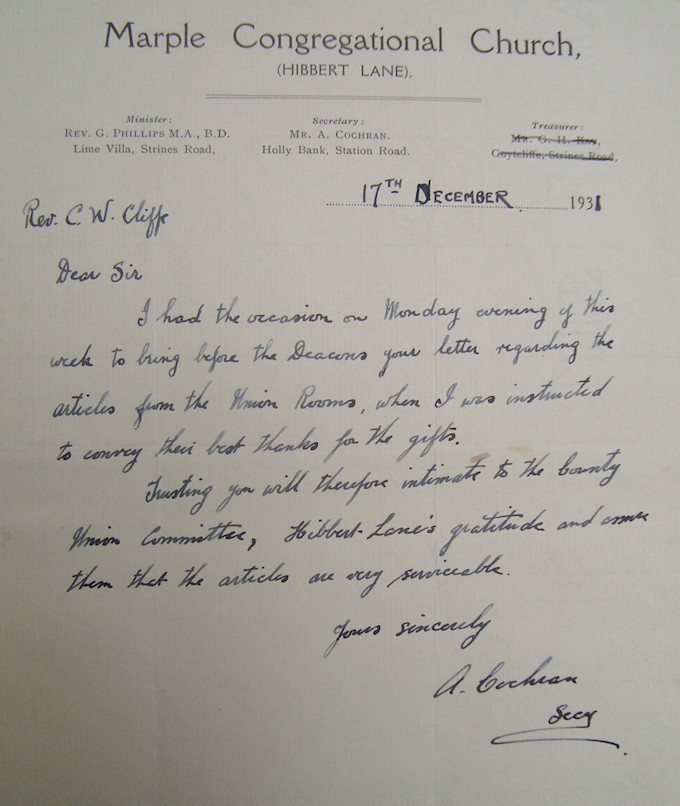 Letter concerning articles from the Union Rooms written by A. Cochran
Letter concerning articles from the Union Rooms written by A. Cochran
There is no family history to say whether Hugh Lane and Margaret Cochran knew each other when they were at The Albert Schools as young children. There was only one year difference in their ages, and as it was not a huge school with many hundreds of children, they surely must have been aware of each other at least. Hugh’s family did not attend the Congregational church, or go to the Sunday School at The Albert Schools, so they would have moved in different circles outside of school. It is not until some eight years or so after leaving school, in about 1930, that they were to meet up again as members of Marple Tennis Club.
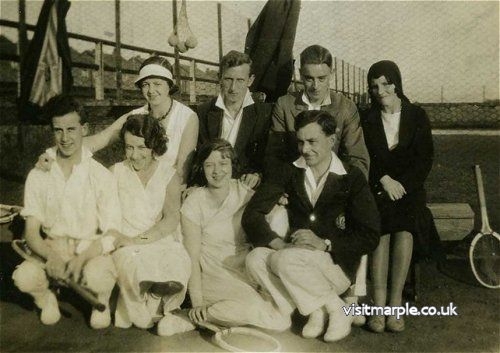 At Marple Tennis Club about 1931. Margaret Cochran is at the back wearing the sun visor. Hugh Lane is sitting next to her.
At Marple Tennis Club about 1931. Margaret Cochran is at the back wearing the sun visor. Hugh Lane is sitting next to her.
Hugh and Margaret were married in 1938 at the Congregational Church. By 1965, they had bought a home at 1 Lyme Grove in Marple, and moved there along with their three children, (myself and my two brothers), my older brother being born in 1945, and myself and my twin brother in 1949.

Wedding of Hugh Lane and Margaret Cochran in 1938
Lyme Grove, a pleasant tree lined little residential street, runs to the side of the Congregational Church, and number 1 is directly behind the church. This made it very convenient to attend all the various activities at the church, and our house was a depository for the keys for the church. It was not unusual for someone to call for the keys, and then just drop them through our letter box once they had finished.
My mother was an elder of the church, a Sunday School teacher, a member of many of the Church groups and an organiser of many activities, both at the Church and at The Albert Schools. Added to which, just over the back wall of the garden of our house at 1 Lyme Grove was the back yard of The Albert Schools!, and I can remember clambering over the wall at the bottom of out garden as a shortcut, instead of taking the longer route down Lyme Grove, along Hibbert Lane, and up Church Lane. A walk of all of a few hundred yards.
The Albert Schools was visible from the back of our house, and as my bedroom was at the back of the house, I spent many hours staring out of the window towards Market Street, with the back of The Albert Schools prominently in the centre of my view.
Following in my grandparents’ and parents’ footsteps, we not only attended the Congregational Church, but also spent a great deal of time at The Albert Schools. I went to the Sunday School there of course, moving through the various rooms as I got older, and then becoming a Sunday School teacher myself. The Scripture Union were involved in some activities, and both I and my brother can remember taking ‘tests’ about Bible knowledge, composing words to hymns, and taking part in quizzes, held in the room to the left of the front door in The Albert Schools. Certificates and prizes were given out, and we remember them being fun things to do - possibly because we received those certificates and prizes for our efforts!

I also remember helping out at Saturday ‘coffee mornings’, when my mother, my aunt, and the other good ladies of the church, would put out small tables. (with embroidered tablecloths of course, and little posies of flowers if some could be found), in the large room downstairs to the left of the front door. The downstairs kitchen, housing a hot water urn, a sink, and cupboards with cups, saucers and plates, was a little room to the right up the few wooden steps from the front door, towards the back of the building. It led to a side door by the old stone steps going up to the first floor. Every time I took a tray of cups and saucers filled with tea to the ‘cafe’ room, it meant going down the few wooden steps towards the front door. Not an easy task for a child, as you couldn’t see the steps with the tea tray in front of you.
The ‘coffee morning’ was the equivalent of the local cafe I suppose, and many people would pop in whilst out doing the shopping for a cup of coffee or tea with biscuits. It served as a meeting place for a chat and a drink - exactly the same as cafes today.
In 1929, the Procession of Witnesses, together with a Rose Queen ceremony, which was held in The Albert Schools, were commenced by the Congregational Church. This lasted up until about 1955. My older brother is carrying the banner in the image above right, taken about 1954.
Again about 1954, this is inside The Albert Schools in the big room upstairs, at the crowning of the Rose Queen ceremony. My twin brother and I are taking our responsibilities very seriously! The eyes of all the important people of the church are upon us.
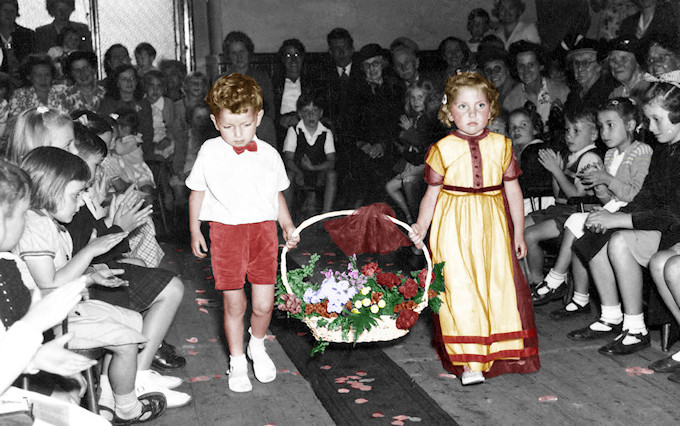 Attendants at a Rose Queen ceremony in the Albert Schools c1954
Attendants at a Rose Queen ceremony in the Albert Schools c1954
The Albert Schools hosted a multitude of events and activities, and a very large part of mine and my brothers’ childhoods were spent there. Aside from Sunday school every week, and coffee mornings as above, I remember jumble sales in the big hall upstairs, which involved setting up all the trestle tables and piling bags and boxes of unwanted clothes and other goods onto them the evening before the sale. At the appointed hour on Saturday morning, the main doors of the hall at the top of the stairs were opened, 6d was paid to enter the room, and let the chaos begin! Many a bargain was to be had for 2d, 3d or 6d! Recycling would seem to be nothing new. The remnants of the sales would then be bagged up for the rag and bone man, whom I can remember going through Marple with his horse and cart, crying ‘ragbone’.
There were also bring and buy sales, again in the room to the left of the front door. These were a little more refined then the jumble sales. The good ladies of the church would make jams, cakes, knitted and sewn items etc. Having brought in their particular contribution, they would then also buy something that another member had brought to be sold.
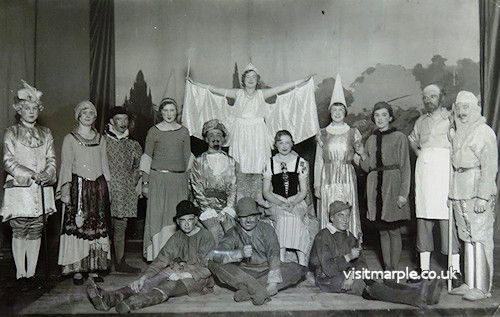 A pre-WWII pantomime at the Albert Schools
A pre-WWII pantomime at the Albert Schools
Other activities that took place in the large hall upstairs were various concerts, including a Christmas Concert, Gilbert & Sullivan operas, talent shows and the annual Harvest Supper. This was an event not to be missed! Long runs of trestle tables were set up and covered with white cloths. The large room to the left at the top of the stairs, from which you could also access the back of the hall, was the kitchen, where many hot pots were kept warm until it was time to serve the meal. It was a very cheerful occasion; warm, busy and with delicious food to eat.
In the late 1950s and early 1960s, my father was one of the leaders of the Youth Club in The Albert Schools. We would play (or attempt to play!), badminton, table tennis, chess and other board games. I think we were even allowed to listen to ‘pop’ music in the kitchen! It was a place to meet other young people away from home under the watchful eyes of adults. And in the early 1960s I remember going to a Young Person’s discussion group. held in again in the kitchen.
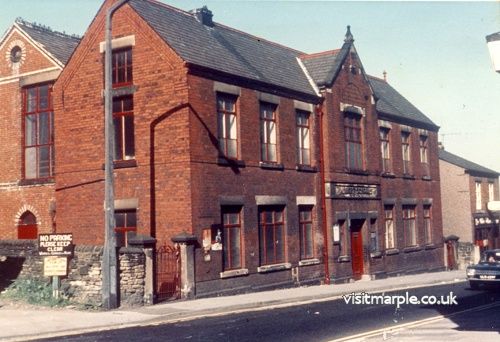 The Albert Schools building in 1968
The Albert Schools building in 1968
There were no doubt other groups and activities held at The Albert Schools of which I, as a child, would have been unaware. In the Year Book for 1962, various other groups are mentioned, who no doubt met in The Albert Schools, were The Guild; The Girls Life Brigade; The Livingstone Fellowship; The Rambling Club; The Women’s Circle , and The Young Wives.
Built in 1866, sold in the 1960s, and demolished in 2019, The Albert Schools provided religious and secular education to hundreds of Marple’s children and young people for about 100 years. They provided a meeting place for a myriad of activities, initially related to the Congregational Church, but later on to other community groups within Marple.
A part of Marple’s history now gone, but hopefully not forgotten.



